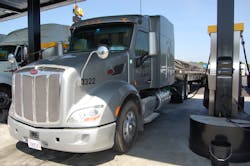Average retail pump prices for diesel and gasoline in the U.S. continued increasing this week, according to data tracked by the Energy Information Administration (EIA), with gasoline prices cracking the $3-per-gallon mark on the West Coast in large part due to a refinery explosion.
The national average for diesel in the U.S. jumped 3.6 cents to $2.936 per gallon, the agency noted, though that is $1.08 per gallon lower compared to the same week in 2014.
Diesel prices went up in every region of the country this week, EIA said, with the highest a 13.3 cent hike to $3.293 per gallon in the Central Atlantic area. New England followed with an 11.8 cent hike to $3.291, while the East Coast sported the third highest jump at 7.8 cents to $3.083.
The West Coast and California rounded out the regions where diesel exceeded the $3-per-gallon-mark, with 3.2 cent jump to $3.097 per gallon and 2.1 cent hike to $3.229, respectively – though the West Coast sported a 4.5 cent hike to $2.934 per gallon with California removed from its pricing mix, according to EIA’s numbers.
The national average for gasoline shot up 14.1 cents this week to $2.473 per gallon, the agency noted, though that’s $1.006 per gallon cheaper compared to the same week in 2014.
Gasoline prices increased in every region of the country this week, with the West Coast sporting a big 37.2 cent bump up to $3.130 per gallon – making it the only region in the nation where gasoline exceeded the $3-per-gallon-mark. Without California included, though, West Coast gasoline prices increased 22.1 cents to $2.632 per gallon.
Price hikes exceeding 10 cents per gallon affected three other areas: New England (up 10.1 cents to $2.40), the Midwest (up 10.4 cents to $2.378) and the Gulf Coast (up 10.6 cents to $2.215).
EIA emphasized that a good portion of those gasoline price hikes are due to an explosion and fire at ExxonMobil's refinery in Torrance, CA, back on February 18 – taking the third-largest refinery in Southern California, or about 20% of the region's fluid catalytic cracking capacity, off line.
The agency stressed that unplanned refinery outages like this one can have noticeable effects on liquid fuel markets, disrupting supplies of gasoline and distillate -- particularly in regions that are tightly balanced such as the West Coast.
Bracketed by the Pacific Ocean and the Rocky Mountains, the mainland portion of the West Coast region is relatively isolated from other U.S. markets and located far from international sources of supply, thus making it much more dependent on in-region production to meet fuel demand – which is why a refinery outage of this magnitude can cause prices to spike quickly, the agency said.
Additionally, California's more-restrictive gasoline specifications limit the availability of supply from other markets, EIA added.
About the Author
Sean Kilcarr
Editor in Chief
Sean Kilcarr is a former longtime FleetOwner senior editor who wrote for the publication from 2000 to 2018. He served as editor-in-chief from 2017 to 2018.
